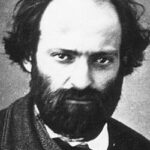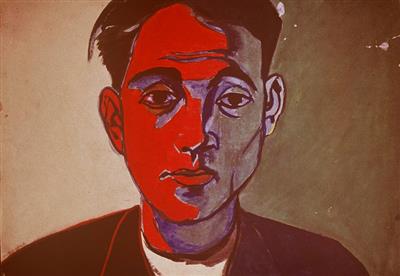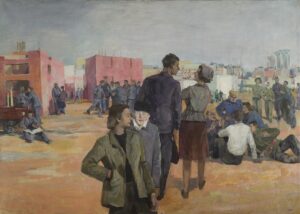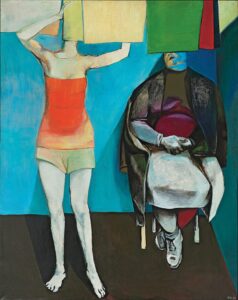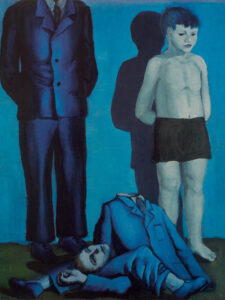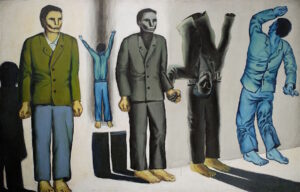Andrzej Wróblewski (1927–1957)
The greatest drama of Polish painting – a genius who faded too soon.
-
Style: He created figurative paintings full of expression and existential tension. His most famous series is Executions – fragmented, chillingly cold images depicting death during the war.
-
Technique: He combined academic training with radical form. Used flat color patches, body deformation, and emotional perspective.
-
Life: He died tragically at the age of 29 in the mountains. His death became a symbol of a lost generation.
-
Trivia: He had great writing skills – his diaries and notes reveal a deeply philosophical mind.
-
For us today: Wróblewski speaks the language of trauma, memory, and dissent. His paintings teach us to look at history without illusions.
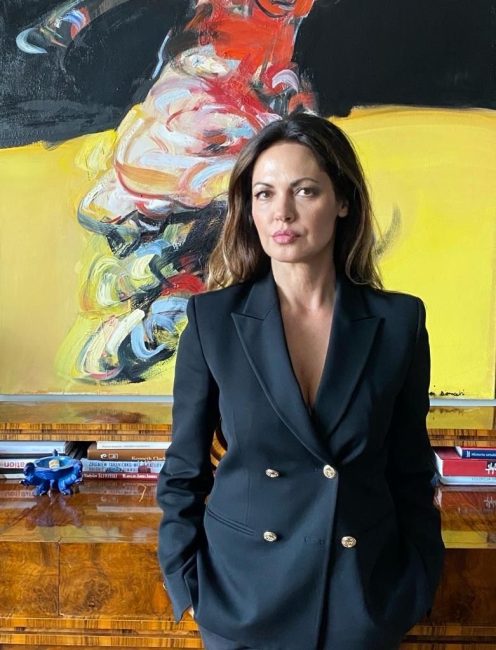 Joanna Piotrowska - Art Advisor & Marszand
Joanna Piotrowska - Art Advisor & Marszand
Biography
Andrzej Krystyn Wróblewski was a Polish painter, art historian, and critic, considered one of the most prominent Polish artists of the second half of the 20th century. His art was centered on the human figure and its fate, profoundly influenced by his wartime experiences. His works include thematic cycles reflecting war tragedies and social realities. He was also a pedagogue at the Academy of Fine Arts in Krakow and contributed critically to artistic discourse.
Early Life and Education
Born in Wilno in 1927, son of a law professor and a graphic artist, Wróblewski showed early talent in art, learning woodcut techniques from his mother. During WWII, he participated in secret education. After the war, he studied art history at Jagiellonian University and painting at Krakow Academy of Fine Arts.
Artistic Career and Style
Debuted in 1948, focusing primarily on the human figure. His work initially reflected social realism and abstract experiments. Post-1955, he returned to figurative painting marked by metaphor and moodiness, often addressing themes of mortality with prophetic intensity.
Notable Works
Significant works include the cycle 'Rozstrzelanie' (The Executions), 'Kolejka trwa' (The Queue Continues), and 'Cień Hiroszimy' (Shadow of Hiroshima). His art inspired literary and musical creations.
Teaching and Legacy
Wróblewski was an assistant and mentor at the Krakow Academy of Fine Arts and led the Self-Education Group that included prominent artists and filmmakers. He was an active art critic and is commemorated through a foundation promoting his legacy.
Nationality
Polish
Categories
Art critic, Art historian, Graphics, Painter, Painting
Themes
Human condition, war aftermath, social realism, abstraction, metaphoric imagery, death
Art works
Fajrant in Nowa Huta
- Artist: Andrzej Wróblewski
- Year: 1953
Blue Chauffeur
- Artist: Andrzej Wróblewski
- Year: 1948
Queue
- Artist: Andrzej Wróblewski
- Year: 1956
Washing
- Artist: Andrzej Wróblewski
- Year: 1955
Execution V
- Artist: Andrzej Wróblewski
- Year: 1949
Execution
- Artist: Andrzej Wróblewski
- Year: 1949
Artists
- Alfred Lenica
- Amedeo Modigliani
- Andy Warhol
- Claude Monet
- Diego Velázquez
- Edouard Manet
- Edvard Munch
- Edward Dwurnik
- Ewa Juszkiewicz
- Franciszek Starowieyski
- Gerhard Richter
- Gustav Klimt
- Henri Matisse
- Henryk Stażewski
- Jackson Pollock
- Jan Berdyszak
- Jan Dobkowski
- Jan Lebenstein
- Jan Tarasin
- Jan Ziemski
- Jean-Michel Basquiat
- Jerzy Duda-Gracz
- Jerzy Nowosielski
- Jerzy Tchórzewski
- Kiejstut Bereźnicki
- Leon Tarasewicz
- Leonardo da Vinci
- Magdalena Abakanowicz
- Mark Rothko
- Pablo Picasso
- Paul Cézanne
- Peter Paul Rubens
- Pierre-Auguste Renoir
- Rembrandt van Rijn
- Rene Magritte
- Roman Opałka
- Roy Lichtenstein
- Ryszard Winiarski
- Sandro Botticelli
- Stefan Gierowski
- Tadeusz Kantor
- Tadeusz Makowski
- Tamara Lempicka
- Vincent van Gogh
- Wojciech Fangor
- Zdzisław Beksiński







